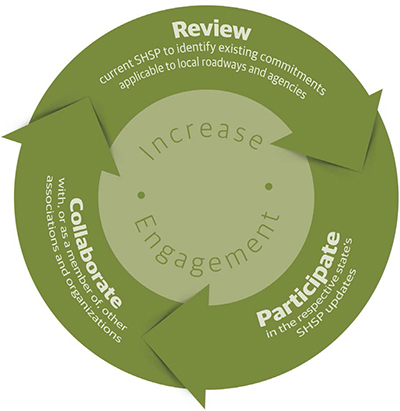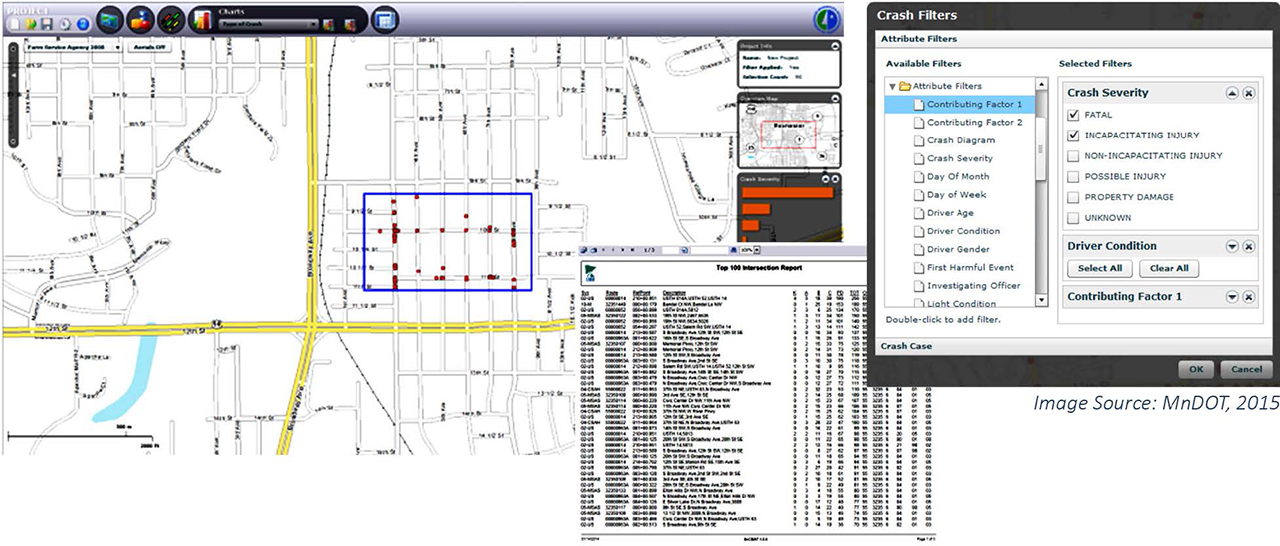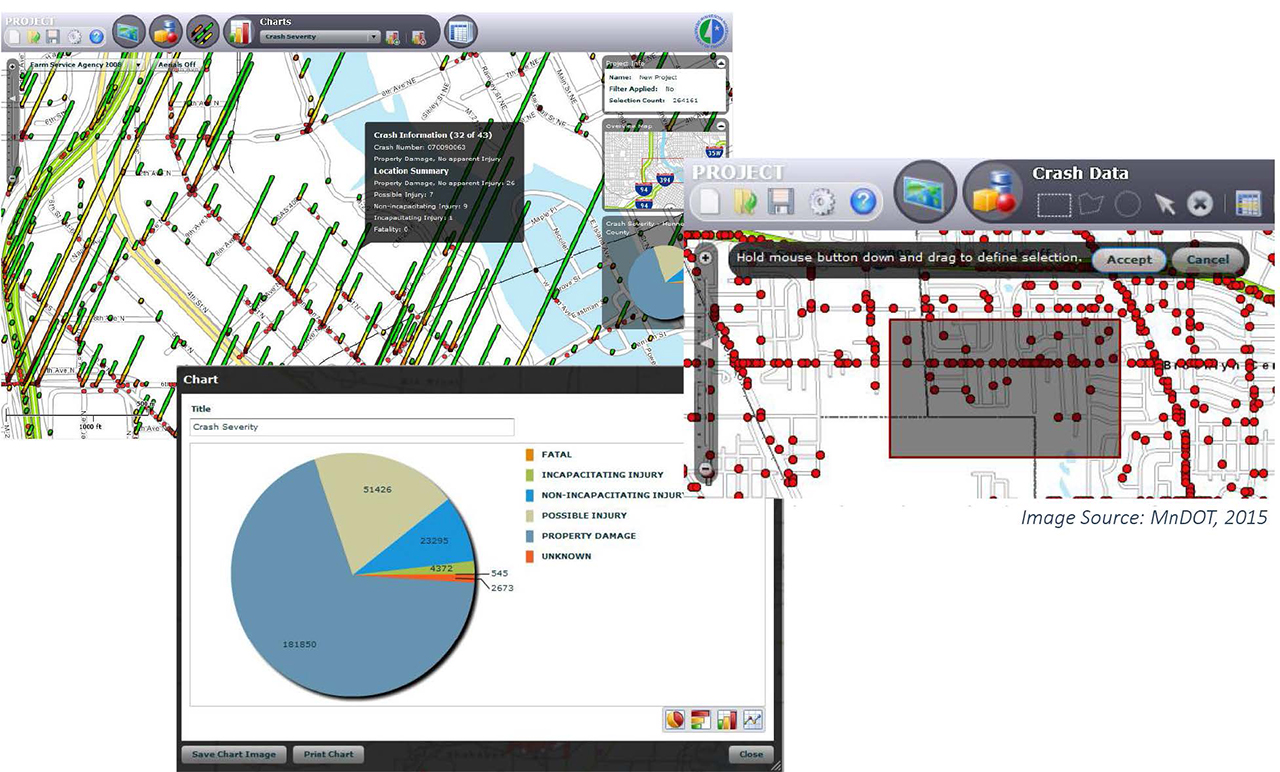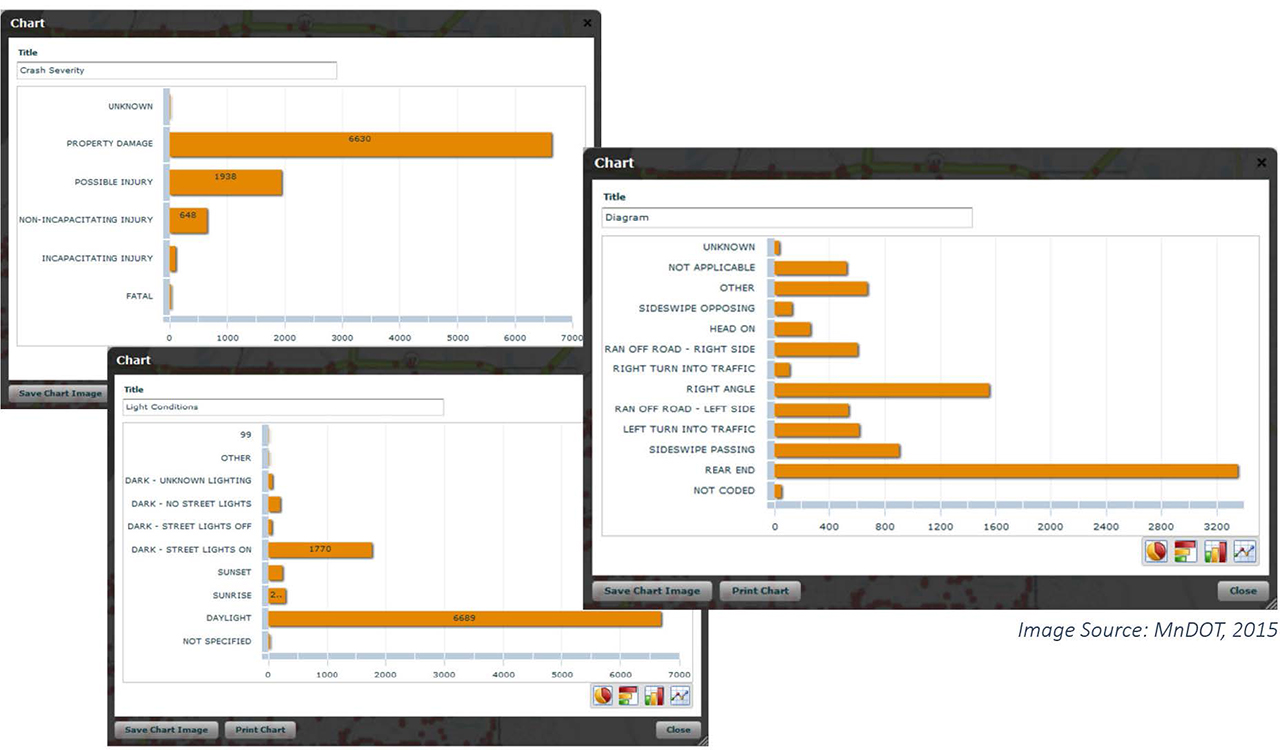
Source: FHWA
A state DOT’s collaboration with local agencies who have successfully implemented safety measures is critical to planning efforts. Frequently, local agencies are not sufficiently engaged during project identification and development to effectively implement the recommended measures. This case study shows how North Dakota DOT (NDDOT) and New Jersey DOT (NJDOT) are addressing this issue by including commitments in their Strategic Highway Safety Plan (SHSP) to:
The first step is to identify existing commitments related to local agency participation. These are often listed in the state’s SHSP. When reviewing the SHSP, a few questions to ask are:
If this information is provided in the state SHSP, the local agency can contact the SHSP program coordinator to ask for information about how to participate in the safety planning process and develop safety practices. If not, the local agency can contact the state’s SHSP program coordinator and advocate for local agency input to the next SHSP. An agency may offer to participate as either a member of an Advisory Committee and/or a representative of a statewide association of counties, cities, or metropolitan planning organizations (MPOs).
To increase the level of involvement, local agencies should collect updated data, participate in training and development, and request technical assistance and implementation support. A state DOT’s commitment to increasing available resources for local road safety may include providing:
The following examples show NDDOT’s and NJDOT’s commitment to local road safety.
As stated in the North Dakota SHSP, NDDOT successfully implemented and documented safety practices. “The statewide Highway Safety Improvement Program will include all roads by increasing the level of engagement of local highway agencies in the HSIP. The specific steps that NDDOT will take to increase the level of participation by local agencies includes the following:
NDDOT provided technical assistance and funding to prepare safety plans for 53 counties and 12 cities in the state of North Dakota. In Fiscal Year 2017, the state allocated approximately 35% of its HSIP funding to support safety project implementation on local roads. In previous years, the allocation was only 2%.
NJDOT has increased available resources by committing funding and training/technical support to local agencies. The SHSP states, “(NJDOT)…supports safety on local systems through the dedication of HSIP funds and by providing technical assistance” (NJDOT, 2015).

NJDOT has also incorporated a system for accountability and performance measures to ensure projects are correctly approved and managed. For example, local safety projects must be approved by a Technical Review Committee, made up of representatives from MPOs and staff from NJDOT’s Local Aid, Environmental Services, and Safety Programs. The U.S. Federal Highway Administration (FHWA) also sits on the Committee as a non-voting member. Once the project is approved, NJDOT holds recurring meetings to track the project’s progress and outcome.
NDDOT and NJDOT have successfully increased local agency participation in safety planning through close collaboration and engagement. To become engaged, a local agency could:
Shawn Kuntz
North Dakota Department of Transportation
(701) 328-2673
Daniel Lisanti
New Jersey Department of Transportation
(609) 530-5742
Minnesota Department of Transportation (MnDOT) developed the Minnesota Crash Mapping Analysis Tool (MnCMAT) to increase the accessibility and user-friendly features of its crash data. MnDOT’s Division of State Aid for Local Transportation partnered with the Minnesota Local Road Research Board and the Minnesota County Engineers Association to develop the analysis tool. MnCMAT is a web-based application that provides 10 years of crash data for public roads in Minnesota. Individual crashes are spatially located along public roadways and up to 67 pieces of information are provided for each crash.
MnDOT’s original computer-based crash record system was used for more than 40 years and used reference points to locate features along a linear element. In addition to providing a location for each crash in the state, more than 15 data elements were documented from the investigating officers’ crash reports, including:
The data output was provided to local agencies in response to requests for crash data. However, few local agencies used the data regularly because the output was not considered user friendly.
The concept of a crash mapping analysis tool was first developed in the 1990s by the Iowa DOT and Iowa State University’s Center for Transportation Research and Education. Following a demonstration of the desktop-based mapping tool at a county engineer’s peer exchange in 2006, MnDOT (with funding support from county engineers) and the Local Road Research Board modified the mapping tool to a web-based application meeting the crash data needs of Minnesota.
MnCMAT is currently used by Minnesota’s city and county engineers, law enforcement, and other traffic safety experts to conduct analyses across state and local roadways. Users have access to crash data in multiple formats in addition to macroscopic (large scale coverage plus trends and statistics) and microscopic (small scale coverage showing crash details) analyses.
Mark Vizecky
Minnesota Department of Transportation
(651) 366-3839
Daniel Lisanti
Minnesota Department of Transportation – State Aid for Local Transportation
(651) 296-3000
Key features include:
MnDOT has successfully developed a web-based system that improves crash data accessibility and analysis capabilities. To expedite the development of similar platforms, a local agency could:
Figure 2-1. Examples of the Crash Mapping Analysis Tool Filters

Figure 2-2. Stacking Function of the Crash Mapping Analysis Tool

Figure 2-3. Examples of the Crash Mapping Analysis Tool Reporting Capabilities

A funding process that considers the constrained resources of local public agencies and simplifies the funding applications is critical to enabling local agencies access to HSIP funds. One solution is to provide guidance to local agencies to help them successfully complete the application. The New Hampshire Department of Transportation’s (NHDOT) HSIP Manual and Guidance (2013) document is a good example of this approach.
The purpose of the Manual is, “to provide documentation and guidance to NHDOT staff and other safety stakeholders involved with implementing the HSIP in New Hampshire.” The Manual was developed by an HSIP Committee directed by NHDOT staff and includes representatives from NHDOT, U.S. Federal Highway Administration (FHWA), local state agencies, metropolitan planning organizations (MPOs), and regional development commissions.
The HSIP Manual and Guidance document includes an overview of key principles of New Hampshire’s HSIP, including (NHDOT, 2013):
The Manual also describes NHDOT’s three-step HSIP selection process (NHDOT, 2013).
NHDOT considers projects that are quick, low-cost, have minimal environmental and right-of way impacts, and are expected to make significant improvements in safety to be the most effective. Even though systemic and non-infrastructure projects may not have all the data required, the HSIP Committee uses best judgment in fairly and equally evaluating them alongside projects with the necessary data. To help with this evaluation, the Manual includes the one-page Application Spreadsheet (Appendix B) that local agencies can use to provide the required information, including:
In addition, the NHDOT created a Highway Safety Improvement webpage (https://www.nh.gov/dot/org/projectdevelopment/highwaydesign/hwysafetyimprovements/). Local communities and local agency staff can use this site to obtain additional information and guidance on the HSIP process in New Hampshire (request forms, links to FHWA requirements, and the HSIP Manual).
The availability of the HSIP Manual has increased the local agency level of engagement in New Hampshire’s statewide safety planning. Currently, 10% of HSIP projects are implemented on the local system.
NHDOT has successfully resolved the funding application process barrier. To streamline its HSIP application process, a local agency could:
Michael Dugas
New Hampshire Department of Transporation
(603) 271-2604
michael.dugas@dot.nh.gov
To increase local participation in the HSIP process, the Minnesota and North Dakota DOTs developed Local Road Safety Plans (LRSPs) for each of the state counties (Refer to Case Study 10 for detailed information). To expedite project development, they provided local agencies with the HSIP project forms and required data for projects identified in the two state safety plans (approximately 14,000 specific actions at individual locations in Minnesota [Leuer, 2016, pers. comm.] and 3,000 actions in North Dakota [Kuntz, 2016, pers. comm.]). The project forms included the required information to describe the safety program for the funding application (Figure 4-1):
Derek Leuer
Minnesota Department of Transportation
(651) 234-7372
Shawn Kuntz
North Dakota Department of Transportation
(701) 328-2673
Local agency staff and DOT HSIP manager feedback on this successful program indicated:
Local participation in the North Dakota HSIPs increased after agencies received additional assistance (Kuntz, 2016, pers. comm.). In Minnesota 85% of the counties have secured HSIP funding for at least one project directly through the assisted applications (Leuer, 2016, pers. comm.).
Minnesota and North Dakota DOTs have successfully provided local agencies with HSIP project forms and relevant data. Local agencies facing complex HSIP funding applications could:
Figure 4-1. HSIP Project Form Example

Source: NDDOT, 2017
RSPCB Program Point of Contact
Felix Delgado, FHWA Office of Safety
Felix.Delgado@dot.gov
FHWA Office of Safety
Staff and Primary Work Responsibilities
FHWA Office of Safety
Safety and Design Team
FHWA Resource Center